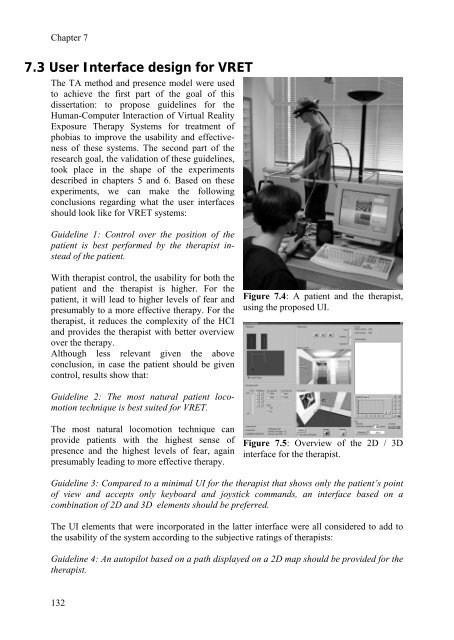Human-Computer Interaction and Presence in Virtual Reality
Human-Computer Interaction and Presence in Virtual Reality
Human-Computer Interaction and Presence in Virtual Reality
Create successful ePaper yourself
Turn your PDF publications into a flip-book with our unique Google optimized e-Paper software.
Chapter 7<br />
7.3 User Interface design for VRET<br />
The TA method <strong>and</strong> presence model were used<br />
to achieve the first part of the goal of this<br />
dissertation: to propose guidel<strong>in</strong>es for the<br />
<strong>Human</strong>-<strong>Computer</strong> <strong>Interaction</strong> of <strong>Virtual</strong> <strong>Reality</strong><br />
Exposure Therapy Systems for treatment of<br />
phobias to improve the usability <strong>and</strong> effectiveness<br />
of these systems. The second part of the<br />
research goal, the validation of these guidel<strong>in</strong>es,<br />
took place <strong>in</strong> the shape of the experiments<br />
described <strong>in</strong> chapters 5 <strong>and</strong> 6. Based on these<br />
experiments, we can make the follow<strong>in</strong>g<br />
conclusions regard<strong>in</strong>g what the user <strong>in</strong>terfaces<br />
should look like for VRET systems:<br />
Guidel<strong>in</strong>e 1: Control over the position of the<br />
patient is best performed by the therapist <strong>in</strong>stead<br />
of the patient.<br />
With therapist control, the usability for both the<br />
patient <strong>and</strong> the therapist is higher. For the<br />
patient, it will lead to higher levels of fear <strong>and</strong><br />
presumably to a more effective therapy. For the<br />
therapist, it reduces the complexity of the HCI<br />
<strong>and</strong> provides the therapist with better overview<br />
over the therapy.<br />
Although less relevant given the above<br />
conclusion, <strong>in</strong> case the patient should be given<br />
control, results show that:<br />
Guidel<strong>in</strong>e 2: The most natural patient locomotion<br />
technique is best suited for VRET.<br />
The most natural locomotion technique can<br />
provide patients with the highest sense of<br />
presence <strong>and</strong> the highest levels of fear, aga<strong>in</strong><br />
presumably lead<strong>in</strong>g to more effective therapy.<br />
Figure 7.4: A patient <strong>and</strong> the therapist,<br />
us<strong>in</strong>g the proposed UI.<br />
Figure 7.5: Overview of the 2D / 3D<br />
<strong>in</strong>terface for the therapist.<br />
Guidel<strong>in</strong>e 3: Compared to a m<strong>in</strong>imal UI for the therapist that shows only the patient’s po<strong>in</strong>t<br />
of view <strong>and</strong> accepts only keyboard <strong>and</strong> joystick comm<strong>and</strong>s, an <strong>in</strong>terface based on a<br />
comb<strong>in</strong>ation of 2D <strong>and</strong> 3D elements should be preferred.<br />
The UI elements that were <strong>in</strong>corporated <strong>in</strong> the latter <strong>in</strong>terface were all considered to add to<br />
the usability of the system accord<strong>in</strong>g to the subjective rat<strong>in</strong>gs of therapists:<br />
Guidel<strong>in</strong>e 4: An autopilot based on a path displayed on a 2D map should be provided for the<br />
therapist.<br />
132
















